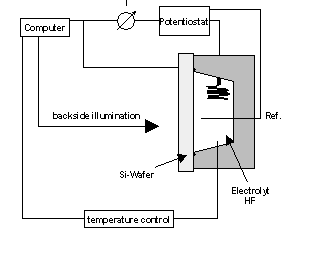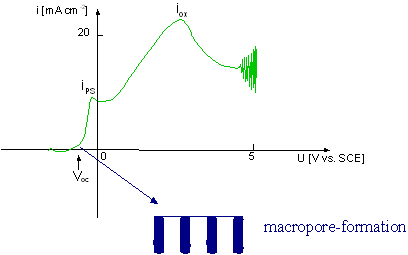| |
Experimental Setup |
| Gerneral remarks | |||
| Silicon electrochemistry, especially in electrolytes containing HF, is used to etch porous silicon. We use a standard three electrode arrangement. The cell is made of Teflon. In addition the electrolyte can be circulated through the cell with a peristaltic pump. The electrolyte-temperature is controlled. A Personal-Computer controlls the wohl etch-system. | |||
 |
|||
| For pore-ecthing an anodic potential is applyed at the silicon-sample. For etching p-type-silicon no backside illumination is needed. | |||
| n-type-silicon | |||
| N-type-silicon is etch in contact to an aqueous HF solutions. The charateristic i-v-curve is shown in the figure. By n-Si the current-density is controlled by the illumination-intensity. | |||
 |
|||
| For etching n-type-silicon a photogeneration of holes is need by back-side-illumination. The photo-current (back-side-illumination intensity) is lower than the cirtical current-density Ips. The anodic etch-potential has to be higher than the critical voltage U(Ips). | |||
 |
|||
| p-type-silicon | |||
| For etching p-type -silicon no backside-illumination is need. Macropores in p-Si were usually etch in organic electrolytes. The Fig shows the i-v-curve of n-Si in contact to an aqueous HF-solution. | |||
| Often used organic solutions with HF for etching p-type silicon are: | |||
| - acetonitril / MeCN - dimetyhlsufloxid / DMSO - dimetyhlformamid / DMF |
|||
| Macropores on p-type-silicon can also be etch in pure aqeuos HF
solutions by applying very low etching-potentials (see Fig). (shown by V. Lehmann and S. Rönnebeck, J. Electrochem. Soc., 1998 submitted) |
|||
 |
|||